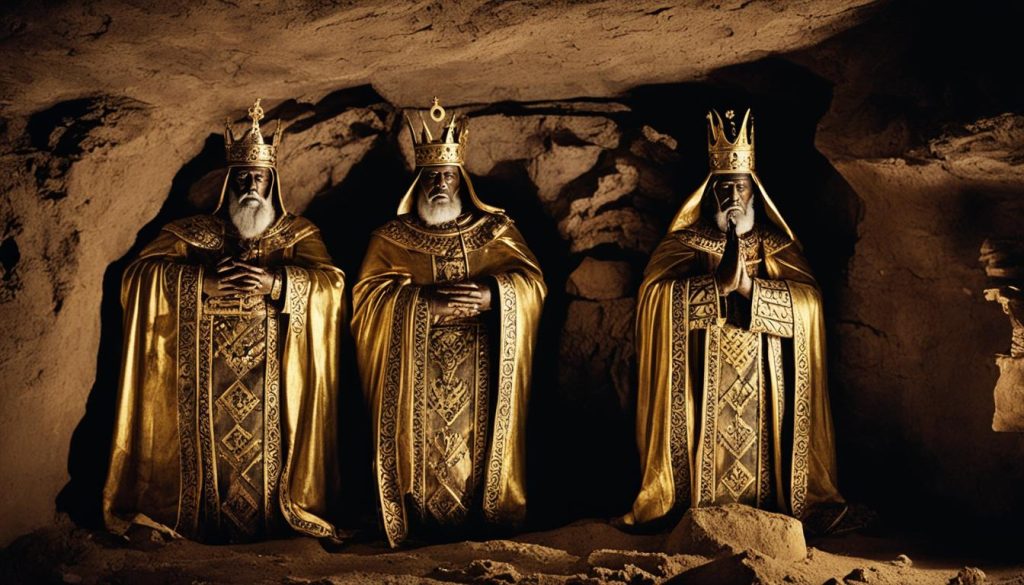The number 2 holds significant biblical and symbolic meaning within the scriptural context and spiritual narratives. It represents a profound union, division, and the verification of facts through witnesses. In both practical and metaphorical senses, the number 2 conveys powerful messages throughout the Bible, revealing deeper truths and spiritual insights.
One of the primary symbolic meanings of the number 2 is the representation of union and partnership. It signifies the sacred bond between a man and a woman in marriage, as well as the spiritual unity between Christ and the church. This symbolism extends to the division of God’s testimony into the Old and New Testaments, each with its distinct purpose and message for humanity. Moreover, the number 2 reflects the dual nature of God the Father and God the Son, highlighting their inseparable yet distinct identities.
Key Takeaways:
- The number 2 in the Bible represents union, division, and the verification of facts through witnesses.
- It symbolizes the unity of a man and woman in marriage and the union between Christ and the church.
- The number 2 signifies the division of God’s testimony into the Old and New Testaments.
- It represents the dual nature of God the Father and God the Son.
- The number 2 is associated with the hope of resurrection and eternal life brought by Jesus as the second Adam.
Biblical References to the Number Two
The number 2 holds significant symbolism and appears throughout the Bible in various contexts. These biblical references contribute to the overall understanding of the symbolic meaning behind the number 2 and its relevance in the Old and New Testaments. Let’s explore some key instances where the number 2 is prominently featured.
1. Absence of “God” in Two Books
Interestingly, the word “God” is not mentioned in only two books of the Bible: the Song of Solomon and Esther. This omission highlights the unique literary style and themes explored in these particular writings.
2. Division of the Old Testament
The Old Testament is structured into three primary divisions: the Law, the Prophets, and the Writings. The second division, known as “the Prophets,” encompasses a significant portion of the Old Testament. This division includes prophetic books such as Isaiah, Jeremiah, and Ezekiel.
3. The Shortest Verse
The shortest verse in the Bible, “Jesus wept,” found in the Gospel of John (11:35), consists of only two words. This concise yet impactful verse offers a glimpse into the compassionate nature of Jesus.
4. Creation of Two Great Lights
During the creation week, God purposely made two significant lights: the sun and the moon. These celestial bodies symbolize the division of day and night, light and darkness, and serve as reminders of God’s creative power.
5. Biblical Writings with “2” in Their Names
There are several biblical writings that are distinguished by the number 2 in their names. These writings include 2 Samuel, 2 Kings, 2 Chronicles, and 2 Corinthians. The number 2 in their titles signifies their unique place within the biblical canon.
These biblical references demonstrate the consistent presence of the number 2 throughout the Old and New Testaments. From the absence of “God” in two books to the division of the Old Testament and the creation of two great lights, the number 2 holds symbolic significance and contributes to a deeper understanding of biblical narratives and teachings.
Biblical References to the Number Two
| Reference | Description |
|---|---|
| Absence of “God” in two books | The Song of Solomon and Esther do not mention the word “God”. |
| Division of the Old Testament | The Old Testament is divided into three sections, with the second division referred to as “the Prophets”. |
| The shortest verse | The verse “Jesus wept” (John 11:35) consists of only two words. |
| Creation of two great lights | God made the sun and the moon as two distinct sources of light during the creation week. |
| Biblical writings with “2” in their names | Several biblical writings, including 2 Samuel, 2 Kings, 2 Chronicles, and 2 Corinthians, have the number 2 in their titles. |
The significance of these references strengthens the symbolic meaning of the number 2 within the biblical context, underlining its importance in divine narratives and teachings.
Two Witnesses in the End Times
According to the book of Revelation, in the End Times, two witnesses will appear on the world scene to testify and uphold the truth of God against the Beast and the False Prophet. These two witnesses will play a crucial role in proclaiming God’s message and standing against the forces of evil. Their presence reinforces the significance of the number 2 in representing testimony and the battle between good and evil.

Revelation 11:3-13
“And I will grant authority to my two witnesses, and they will prophesy for 1,260 days, clothed in sackcloth. These are the two olive trees and the two lampstands that stand before the Lord of the earth. And if anyone would harm them, fire pours from their mouth and consumes their foes. If anyone would harm them, this is how he is doomed to be killed. They have the power to shut the sky, that no rain may fall during the days of their prophesying, and they have power over the waters to turn them into blood and to strike the earth with every kind of plague, as often as they desire. And when they have finished their testimony, the beast that rises from the bottomless pit will make war on them and conquer them and kill them, and their dead bodies will lie in the street of the great city that symbolically is called Sodom and Egypt, where their Lord was crucified. For three and a half days some from the peoples and tribes and languages and nations will gaze at their dead bodies and refuse to let them be placed in a tomb, and those who dwell on the earth will rejoice over them and make merry and exchange presents, because these two prophets had been a torment to those who dwell on the earth. But after the three and a half days a breath of life from God entered them, and they stood up on their feet, and great fear fell on those who saw them. Then they heard a loud voice from heaven saying to them, ‘Come up here!’ And they went up to heaven in a cloud, and their enemies watched them. And at that hour there was a great earthquake, and a tenth of the city fell. Seven thousand people were killed in the earthquake, and the rest were terrified and gave glory to the God of heaven.”
The two witnesses mentioned in the Book of Revelation bring a message of truth and righteousness during a time of great tribulation. Their testimony is powerful and is backed by extraordinary supernatural abilities, such as the ability to prophesy, perform miracles, and bring judgments upon the earth. Their role in the end times serves as a testament to God’s unfailing truth and His unwavering pursuit of justice.
This depiction also highlights the ongoing battle between good and evil, with the Beast and the False Prophet seeking to oppose God’s witnesses. However, despite the temporary victory of the enemy, the witnesses are ultimately resurrected and glorified, signifying the triumph of God’s truth over the forces of darkness.
| Symbolic Elements | Meaning |
|---|---|
| Two Witnesses | The importance of testimony and the presence of two witnesses to establish truth and confirm God’s authority. |
| Beast | A representation of the Antichrist, a powerful and deceptive force seeking to oppose God and His witnesses. |
| False Prophet | An individual who supports the Beast and promotes false teachings, leading people astray from the truth of God. |
The presence of these two witnesses in the end times reminds believers of the ultimate victory of God’s truth and the assurance that His judgment will prevail. It serves as a call to stand firm in faith and bear witness to the truth even in the face of opposition and persecution.
Comparison and Contrast: Old Covenant vs. New Covenant
The number 2 signifies a profound comparison and contrast between the Old Covenant and the New Covenant. In the Old Covenant, the focus was primarily on physical blessings as a result of obedience, such as the requirement of physical circumcision to be included among God’s people. However, in the New Covenant, the emphasis shifts towards spiritual blessings and circumcision of the heart.
Unlike the Old Covenant, which required strict adherence to the letter of the law, the New Covenant places greater importance on the spiritual intent behind the laws. It signifies a transformative shift from external rituals to internal transformation.
“For I will forgive their wickedness and will remember their sins no more.” – Hebrews 8:12
This profound contrast highlights the New Covenant’s remarkable nature, where believers experience spiritual renewal and salvation through faith in Jesus Christ. The Old Covenant’s physical blessings acted as a foreshadowing of the greater spiritual blessings to come under the New Covenant.
To better understand the comparison between the Old and New Covenants, let’s explore a table that highlights the key differences between the two:
| Old Covenant | New Covenant |
|---|---|
| Primarily focused on physical blessings | Emphasizes spiritual blessings |
| Required physical circumcision | Circumcision of the heart |
| Strict adherence to the letter of the law | Emphasis on the spiritual intent behind the laws |
| External rituals | Internal transformation |
The comparison between the Old Covenant and the New Covenant helps us recognize the extraordinary shift from physical to spiritual realities in God’s plan for humanity. Through the New Covenant, believers now have access to the fullness of God’s grace and the transformation of their inner beings by the power of the Holy Spirit.
Symbolism of Two Buried Kings
Two kings of Judah, King Manasseh and King Amon, were buried in their home gardens upon their deaths. This unusual burial practice holds symbolic significance. Manasseh, who reigned for 55 years, was one of the worst kings in terms of leading God’s people, yet he was buried in his own garden in Jerusalem. Amon, Manasseh’s son and successor, was assassinated after ruling for only two years, and he was buried alongside his father. The garden burial of these kings symbolizes the consequences of their actions and the reminder that no one can escape the judgment of God.
| King | Reign | Burial |
|---|---|---|
| King Manasseh | 55 years | His own garden in Jerusalem |
| King Amon | 2 years | Buried alongside his father |
Although King Manasseh’s reign was marked by idolatry and wickedness, his burial in his own garden reflects the consequences of his actions. Even though Amon’s reign was short-lived, being buried next to his father highlights the continuation of God’s judgment. These garden burials serve as powerful reminders of the gravity of their leadership and the eternal consequences of their choices.

Other Appearances and Use of the Number Two
The number 2 holds a significant presence in the Bible, appearing in various contexts and reinforcing its symbolic meaning and significance. Alongside the books of 2 Samuel, 2 Kings, 2 Chronicles, and 2 Corinthians, there are numerous other instances where the number 2 is prominently featured. These appearances further enhance the depth of understanding and interpretation of biblical writings.
One notable example of the number 2 in biblical stories is found in Luke 24, where two men encounter Jesus on the road to Emmaus. This encounter carries profound symbolism, illustrating the presence of companionship and revelation through the power of two.
“And behold, two of them were going to a village named Emmaus, about seven miles from Jerusalem, and they were talking with each other about all these things that had happened. While they were talking and discussing together, Jesus himself drew near and went with them.” – Luke 24:13-15 (ESV)
The occurrence of two witnesses is also a recurring theme in biblical narratives, emphasizing the significance of testimony and verification. For example, in the Old Testament, the Law required at least two witnesses to establish truth and to convict someone of a crime or sin.
By exploring these appearances and associations, we gain a deeper understanding of the symbolism and meaning attached to the number 2 within the Bible. It serves as a reminder of the interconnectedness and balance within biblical narratives, highlighting the importance of partnership, testimony, and spiritual truths.
Conclusion
The number 2 holds significant symbolic meaning and spiritual significance in the Bible. It represents a union, division, testimony, comparison, and contrast. Throughout the biblical narratives and teachings, the number 2 emphasizes divine messages and truths conveyed through numbers. Understanding the symbolic meanings behind numbers, including the number 2, can enhance one’s comprehension of the biblical text and deepen their spiritual understanding.
However, it is essential to approach biblical numerology with caution, avoiding mystical interpretations. The symbolic meanings of numbers should complement and enrich the overall theological context instead of overshadowing it. By keeping biblical numerology within the parameters of scriptural, historical, and cultural understanding, readers can appreciate the depth and richness of the symbolic language in the Bible.
In conclusion, the number 2 in biblical numerology carries profound symbolic meaning and spiritual significance. It conveys various concepts such as unity, division, testimony, comparison, and contrast. By exploring the symbolic language of numbers, readers can gain a deeper understanding of the biblical narratives and the truths they convey.



